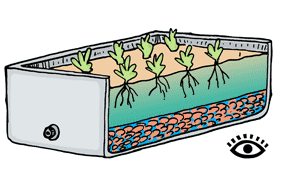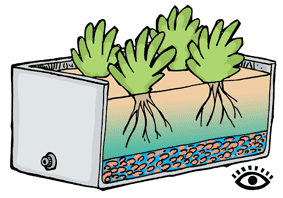vegetable
patch design
Wicking Beds
Wicking bed depths
The accepted wisdom regarding
wicking beds is that water
can only be effectively drawn up from the water reservoir at
the bottom of a wicking bed to a height of around 30 cm.
However this only applies to the osmotic process and does not
take into account the ability of roots to extract water from
much greater depths. Wicking beds can in fact be made
to a variety of depths depending on the size and root
structures of the plants you intend to grow in them.
Below is a rough guide to the different depths for different
sized plants.

Shallow wicking beds with a soil depth of around 15 to 20 centimetres draw the water to the surface of the bed providing ideal conditions for growing seedlings for transplanting.

Wicking beds with a depth of around 35 to 40 centimetres depth are suitable for growing vegetables.
 Deep
wicking beds with a soil depth of 50 centimetres or more are ideal
for containing small trees and shrubs.
Deep
wicking beds with a soil depth of 50 centimetres or more are ideal
for containing small trees and shrubs.There is however not enough space for the roots structure of most mature vegetables.
vegetables : 35 to 40 cm
Wicking beds or tubs with
35 to 40 centimetres of soil above the water reservoir provide a suitable
height for growing vegetables. At this height the soil on the
surface is fairly dry but allows all but the smallest seedlings to reach
the moist area just below the surface with relative ease.At this depth there is not only enough room for the vegetable roots to develop properly the drier soil on the surface reduces the number of weed seeds that germinate.
If you are planting vegetables seeds into wicking beds of this depth you will have to water the seeds from above until the seedlings are big enough for their roots to reach the moister soil below.
small trees & shrubs : 50 plus
cm
Wicking beds or tubs with a soil depth of 50 or more centimetres are
ideal for growing small trees or shrubs. At this depth the surface soil
is very dry, inhibiting weed growth, while the greater volume of soil provides more room for roots to
grow.Wicking tubs of this depth are ideal for growing small trees in a vegetable patch as they prevent the roots from competing directly with nearby vegetables.
Wicking beds and tubs can also be used to contain plants that send out lots of suckers. I have used wicking tubs to contain raspberry canes.

